Trends in Nighttime Fires in South/Southeast Asian Countries
Abstract
1. Introduction
2. Materials and Methods
2.1. VIIRS Data
2.2. SLSTR Data
2.3. Statistical Analysis
3. Results
4. Discussion
Author Contributions
Funding
Institutional Review Board Statement
Informed Consent Statement
Data Availability Statement
Conflicts of Interest
References
- Biswas, S.; Vadrevu, K.P.; Lwin, Z.M.; Lasko, K.; Justice, C.O. Factors Controlling Vegetation Fires in Protected and Non-Protected Areas of Myanmar. PLoS ONE 2015, 10, e0124346. [Google Scholar] [CrossRef] [PubMed]
- Hayasaka, H.; Noguchi, I.; Putra, E.I.; Yulianti, N.; Vadrevu, K. Peat-Fire-Related Air Pollution in Central Kalimantan, Indonesia. Environ. Pollut. 2014, 195, 257–266. [Google Scholar] [CrossRef] [PubMed]
- Inoue, Y. Ecosystem Carbon Stock, Atmosphere, and Food Security in Slash-and-Burn Land Use: A Geospatial Study in Mountainous Region of Laos. In Land-Atmospheric Research Applications in South and Southeast Asia; Springer: Cham, Switzerland, 2018; pp. 641–665. [Google Scholar]
- Lasko, K.; Vadrevu, K.P.; Nguyen, T.T.N. Analysis of Air Pollution over Hanoi, Vietnam Using Multi-Satellite and MERRA Reanalysis Datasets. PLoS ONE 2018, 13, e0196629. [Google Scholar] [CrossRef] [PubMed]
- Lin, N.-H.; Tsay, S.-C.; Maring, H.B.; Yen, M.-C.; Sheu, G.-R.; Wang, S.-H.; Chi, K.H.; Chuang, M.-T.; Ou-Yang, C.-F.; Fu, J.S.; et al. An Overview of Regional Experiments on Biomass Burning Aerosols and Related Pollutants in Southeast Asia: From BASE-ASIA and the Dongsha Experiment to 7-SEAS. Atmos. Environ. 2013, 78, 1–19. [Google Scholar] [CrossRef]
- Crutzen, P.J.; Andreae, M.O. Biomass Burning in the Tropics: Impact on Atmospheric Chemistry and Biogeochemical Cycles. Science 1990, 250, 1669–1678. [Google Scholar] [CrossRef]
- Gupta, P.K.; Krishna Prasad, V.; Sharma, C.; Sarkar, A.K.; Kant, Y.; Badarinath, K.V.S.; Mitra, A.P. CH4 Emissions from Biomass Burning of Shifting Cultivation Areas of Tropical Deciduous Forests—Experimental Results from Ground-Based Measurements. Chemosphere Glob. Chang. Sci. 2001, 3, 133–143. [Google Scholar] [CrossRef]
- Kiely, L.; Spracklen, D.V.; Wiedinmyer, C.; Conibear, L.; Reddington, C.L.; Arnold, S.R.; Knote, C.; Khan, M.F.; Latif, M.T.; Syaufina, L.; et al. Air Quality and Health Impacts of Vegetation and Peat Fires in Equatorial Asia during 2004–2015. Environ. Res. Lett. 2020, 15, 094054. [Google Scholar] [CrossRef]
- Adams, M.A. Mega-Fires, Tipping Points and Ecosystem Services: Managing Forests and Woodlands in an Uncertain Future. For. Ecol. Manag. 2013, 294, 250–261. [Google Scholar] [CrossRef]
- Amorim, H.C.S.; Ashworth, A.J.; Brye, K.R.; Wienhold, B.J.; Savin, M.C.; Owens, P.R.; Silva, S.H.G. Soil Quality Indices as Affected by Long-term Burning, Irrigation, Tillage, and Fertility Management. Soil. Sci. Soc. Am. J. 2021, 85, 379–395. [Google Scholar] [CrossRef]
- Blank, R.R.; Chambers, J.; Roundy, B.; Whittaker, A. Nutrient Availability in Rangeland Soils: Influence of Prescribed Burning, Herbaceous Vegetation Removal, Overseeding with Bromus Tectorum, Season, and Elevation. Rangel. Ecol. Manag. 2007, 60, 644–655. [Google Scholar] [CrossRef]
- Toky, O.P.; Ramakrishnan, P.S. Cropping and Yields in Agricultural Systems of the North-Eastern Hill Region of India. Agro-Ecosystems 1981, 7, 11–25. [Google Scholar] [CrossRef]
- Turner, M.G. Disturbance and Landscape Dynamics in a Changing World. Ecology 2010, 91, 2833–2849. [Google Scholar] [CrossRef] [PubMed]
- Justice, C.O.; Townshend, J.R.G.; Vermote, E.F.; Masuoka, E.; Wolfe, R.E.; Saleous, N.; Roy, D.P.; Morisette, J.T. An Overview of MODIS Land Data Processing and Product Status. Remote Sens. Environ. 2002, 83, 3–15. [Google Scholar] [CrossRef]
- Vadrevu, K.; Ohara, T.; Justice, C. Biomass Burning in South and Southeast Asia Mapping and Monitoring, 1st ed.; CRC Press: Boca Raton, FL, USA, 2021; Volume 1, ISBN 9781032013510. [Google Scholar]
- Vadrevu, K.; Ohara, T.; Justice, C. Biomass Burning in South and Southeast Asia Impacts on the Biosphere, 1st ed.; CRC Press: Boca Raton, FL, USA, 2021; Volume 2, ISBN 9781032013534. [Google Scholar]
- Roberts, G.; Wooster, M.J. Development of a Multi-Temporal Kalman Filter Approach to Geostationary Active Fire Detection & Fire Radiative Power (FRP) Estimation. Remote Sens. Environ. 2014, 152, 392–412. [Google Scholar] [CrossRef]
- Wang, J.; Roudini, S.; Hyer, E.J.; Xu, X.; Zhou, M.; Garcia, L.C.; Reid, J.S.; Peterson, D.A.; da Silva, A.M. Detecting Nighttime Fire Combustion Phase by Hybrid Application of Visible and Infrared Radiation from Suomi NPP VIIRS. Remote Sens. Environ. 2020, 237, 111466. [Google Scholar] [CrossRef]
- Dozier, J. A Method for Satellite Identification of Surface Temperature Fields of Subpixel Resolution. Remote Sens. Environ. 1981, 11, 221–229. [Google Scholar] [CrossRef]
- Elvidge, C.D.; Kroehl, H.W.; Kihn, E.A.; Baugh, K.E.; Davis, E.R. Algorithm for the Retrieval of Fire Pixels from DMSP Operational Linescan System Data. Defense Technical Information Center: Fort Belvoir, VA, USA, 1995. [Google Scholar]
- Mota, B.W.; Pereira, J.M.C.; Oom, D.; Vasconcelos, M.J.P.; Schultz, M. Screening the ESA ATSR-2 World Fire Atlas (1997–2002). Atmos. Chem. Phys. 2006, 6, 1409–1424. [Google Scholar] [CrossRef]
- Giglio, L.; Kendall, J.D.; Tucker, C.J. Remote Sensing of Fires with the TRMM VIRS. Int. J. Remote Sens. 2000, 21, 203–207. [Google Scholar] [CrossRef]
- Kaufman, Y.J.; Kleidman, R.G.; King, M.D. SCAR-B Fires in the Tropics: Properties and Remote Sensing from EOS-MODIS. J. Geophys. Res. Atmos. 1998, 103, 31955–31968. [Google Scholar] [CrossRef]
- Csiszar, I.; Schroeder, W.; Giglio, L.; Ellicott, E.; Vadrevu, K.P.; Justice, C.O.; Wind, B. Active Fires from the Suomi NPP Visible Infrared Imaging Radiometer Suite: Product Status and First Evaluation Results. J. Geophys. Res. Atmos. 2014, 119, 803–816. [Google Scholar] [CrossRef]
- Schroeder, W.; Oliva, P.; Giglio, L.; Csiszar, I.A. The New VIIRS 375 m Active Fire Detection Data Product: Algorithm Description and Initial Assessment. Remote Sens. Environ. 2014, 143, 85–96. [Google Scholar] [CrossRef]
- Prins, E.M.; Feltz, J.M.; Menzel, W.P.; Ward, D.E. An Overview of GOES-8 Diurnal Fire and Smoke Results for SCAR-B and 1995 Fire Season in South America. J. Geophys. Res. Atmos. 1998, 103, 31821–31835. [Google Scholar] [CrossRef]
- Jang, E.; Kang, Y.; Im, J.; Lee, D.-W.; Yoon, J.; Kim, S.-K. Detection and Monitoring of Forest Fires Using Himawari-8 Geostationary Satellite Data in South Korea. Remote Sens. 2019, 11, 271. [Google Scholar] [CrossRef]
- Dozier, J.; Matson, M. Identification of Subresolution High Temperature Sources Using a Thermal IR Sensor. Photogramm. Eng. Remote Sens. 1981, 47, 1311–1318. [Google Scholar]
- Robinson, J.M. Fire from Space: Global Fire Evaluation Using Infrared Remote Sensing. Int. J. Remote Sens. 1991, 12, 3–24. [Google Scholar] [CrossRef]
- Elvidge, C.; Zhizhin, M.; Hsu, F.-C.; Baugh, K. VIIRS Nightfire: Satellite Pyrometry at Night. Remote Sens. 2013, 5, 4423–4449. [Google Scholar] [CrossRef]
- Polivka, T.N.; Wang, J.; Ellison, L.T.; Hyer, E.J.; Ichoku, C.M. Improving Nocturnal Fire Detection with the VIIRS Day–Night Band. IEEE Trans. Geosci. Remote Sens. 2016, 54, 5503–5519. [Google Scholar] [CrossRef]
- Balch, J.K.; Abatzoglou, J.T.; Joseph, M.B.; Koontz, M.J.; Mahood, A.L.; McGlinchy, J.; Cattau, M.E.; Williams, A.P. Warming Weakens the Night-Time Barrier to Global Fire. Nature 2022, 602, 442–448. [Google Scholar] [CrossRef]
- Xu, W.; Wooster, M.J.; He, J.; Zhang, T. First Study of Sentinel-3 SLSTR Active Fire Detection and FRP Retrieval: Night-Time Algorithm Enhancements and Global Intercomparison to MODIS and VIIRS AF Products. Remote Sens. Environ. 2020, 248, 111947. [Google Scholar] [CrossRef]
- Wooster, M.J.; Xu, W.; Nightingale, T. Sentinel-3 SLSTR Active Fire Detection and FRP Product: Pre-Launch Algorithm Development and Performance Evaluation Using MODIS and ASTER Datasets. Remote Sens. Environ. 2012, 120, 236–254. [Google Scholar] [CrossRef]
- Mann, H.B. Nonparametric Tests Against Trend. Econometrica 1945, 13, 245. [Google Scholar] [CrossRef]
- Kendall, M.G. Rank Correlation Methods; Griffin: London, UK, 1975; ISBN 9780852641996. [Google Scholar]
- Sen, P.K. Estimates of the Regression Coefficient Based on Kendall’s Tau. J. Am. Stat. Assoc. 1968, 63, 1379–1389. [Google Scholar] [CrossRef]
- Zhang, T.; Wooster, M.J.; Xu, W. Approaches for Synergistically Exploiting VIIRS I- and M-Band Data in Regional Active Fire Detection and FRP Assessment: A Demonstration with Respect to Agricultural Residue Burning in Eastern China. Remote Sens. Environ. 2017, 198, 407–424. [Google Scholar] [CrossRef]
- Li, P.; Xiao, C.; Feng, Z.; Li, W.; Zhang, X. Occurrence Frequencies and Regional Variations in Visible Infrared Imaging Radiometer Suite (VIIRS) Global Active Fires. Glob. Chang. Biol. 2020, 26, 2970–2987. [Google Scholar] [CrossRef]
- Vadrevu, K.; Lasko, K. Intercomparison of MODIS AQUA and VIIRS I-Band Fires and Emissions in an Agricultural Landscape—Implications for Air Pollution Research. Remote Sens. 2018, 10, 978. [Google Scholar] [CrossRef]
- Agee, J.K.; Lolley, M.R. Thinning and prescribed fire effects on fuels and potential fire behavior in an eastern Cascades forest, Washington, USA. Fire Ecol. 2006, 2, 3–19. [Google Scholar] [CrossRef]
- Mell, W.E.; Manzello, S.L.; Maranghides, A.; Butry, D.; Rehm, R.G. The wildland–urban interface fire problem–current approaches and research needs. Int. J. Wildland Fire 2010, 19, 238–251. [Google Scholar] [CrossRef]
- Calkin, D.E.; Cohen, J.D.; Finney, M.A.; Thompson, M.P. How risk management can prevent future wildfire disasters in the wildland-urban interface. Proc. Natl. Acad. Sci. USA 2014, 111, 746–751. [Google Scholar] [CrossRef]
- Li, S.; Dao, V.; Kumar, M.; Nguyen, P.; Banerjee, T. Mapping the wildland-urban interface in California using remote sensing data. Sci. Rep. 2022, 12, 5789. [Google Scholar] [CrossRef]
- Defossé, G.E. Fires in the wildland urban interface: An emerging global phenomenon threatening modern society. Front. For. Glob. Chang. 2023, 6, 1137014. [Google Scholar] [CrossRef]
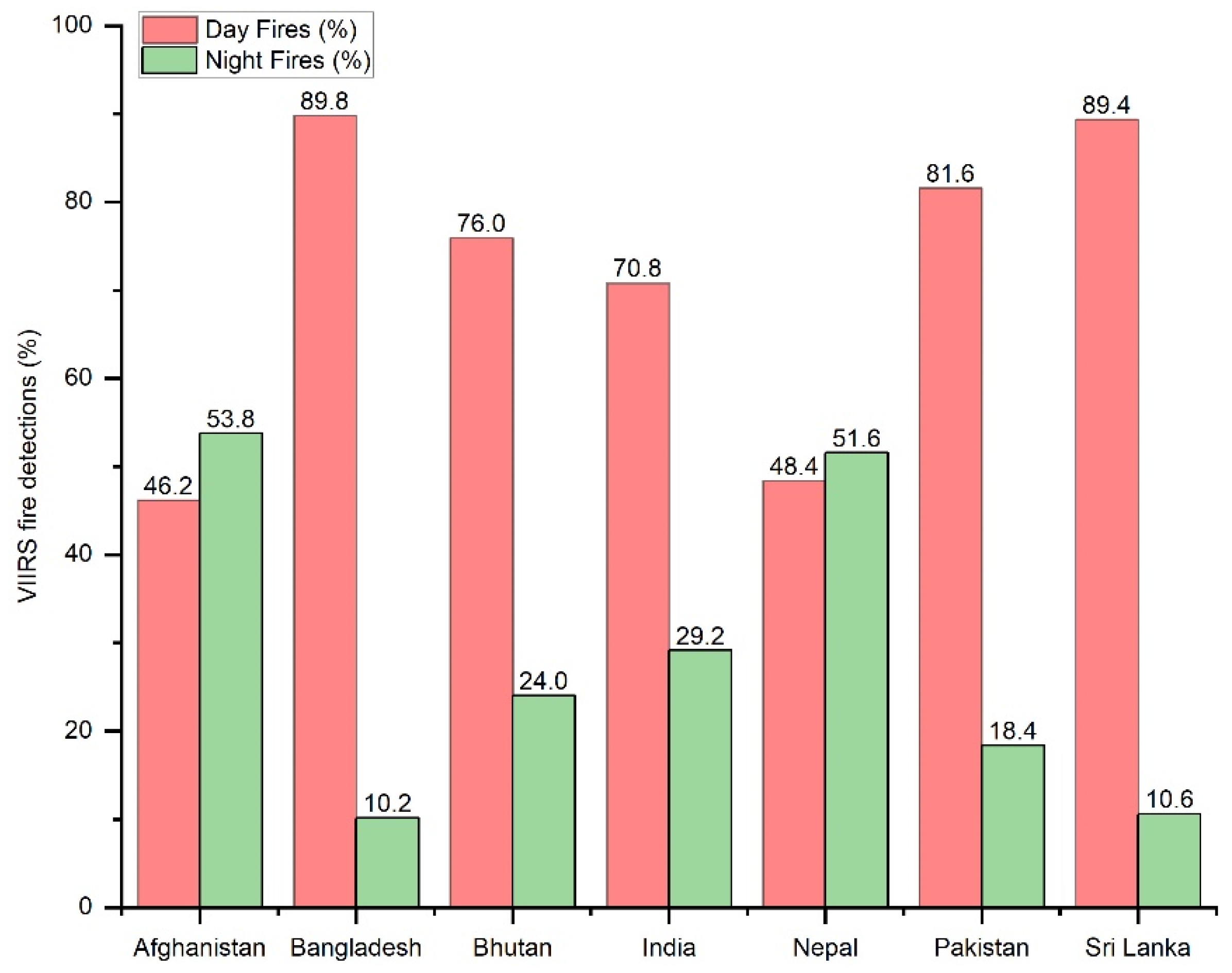
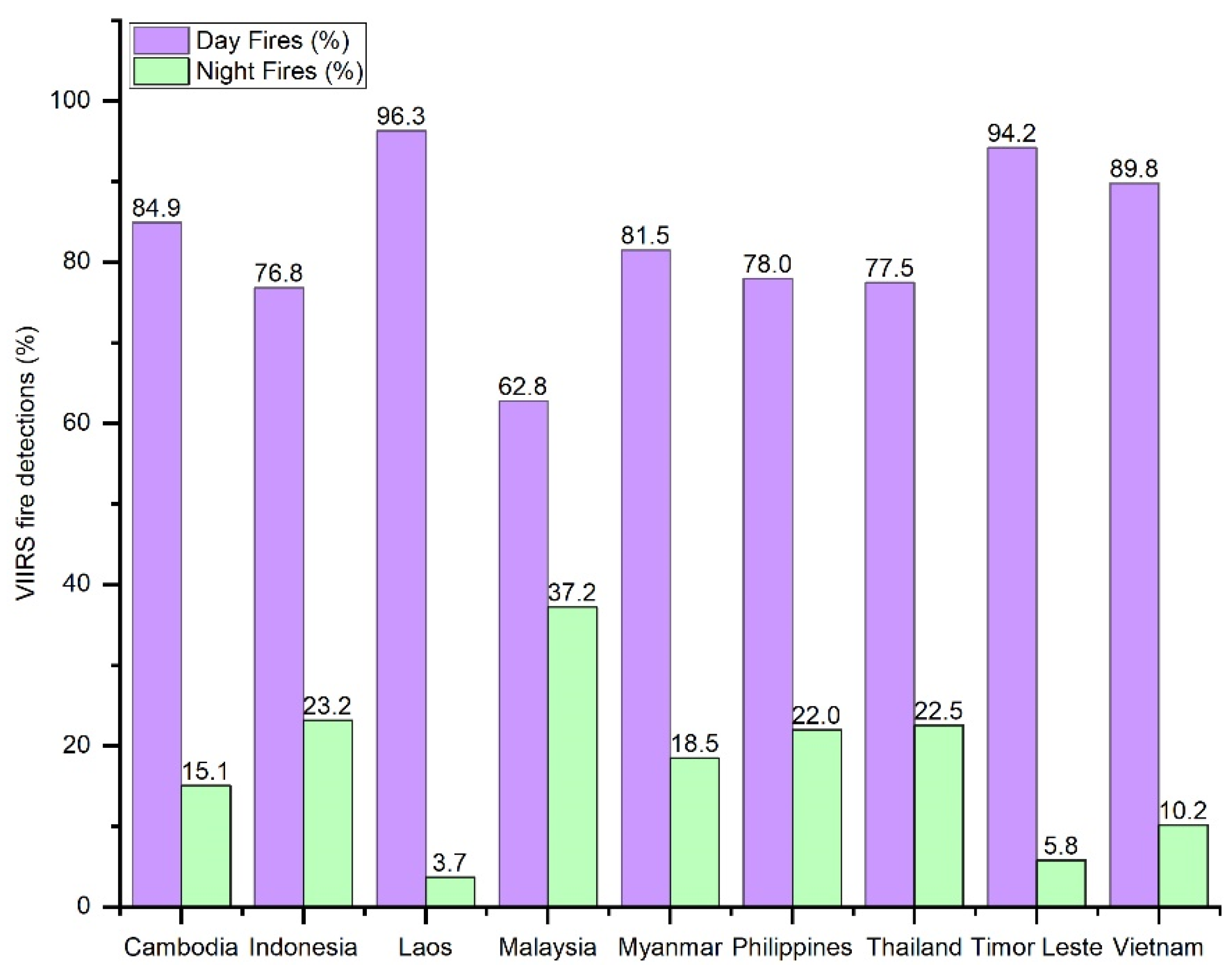
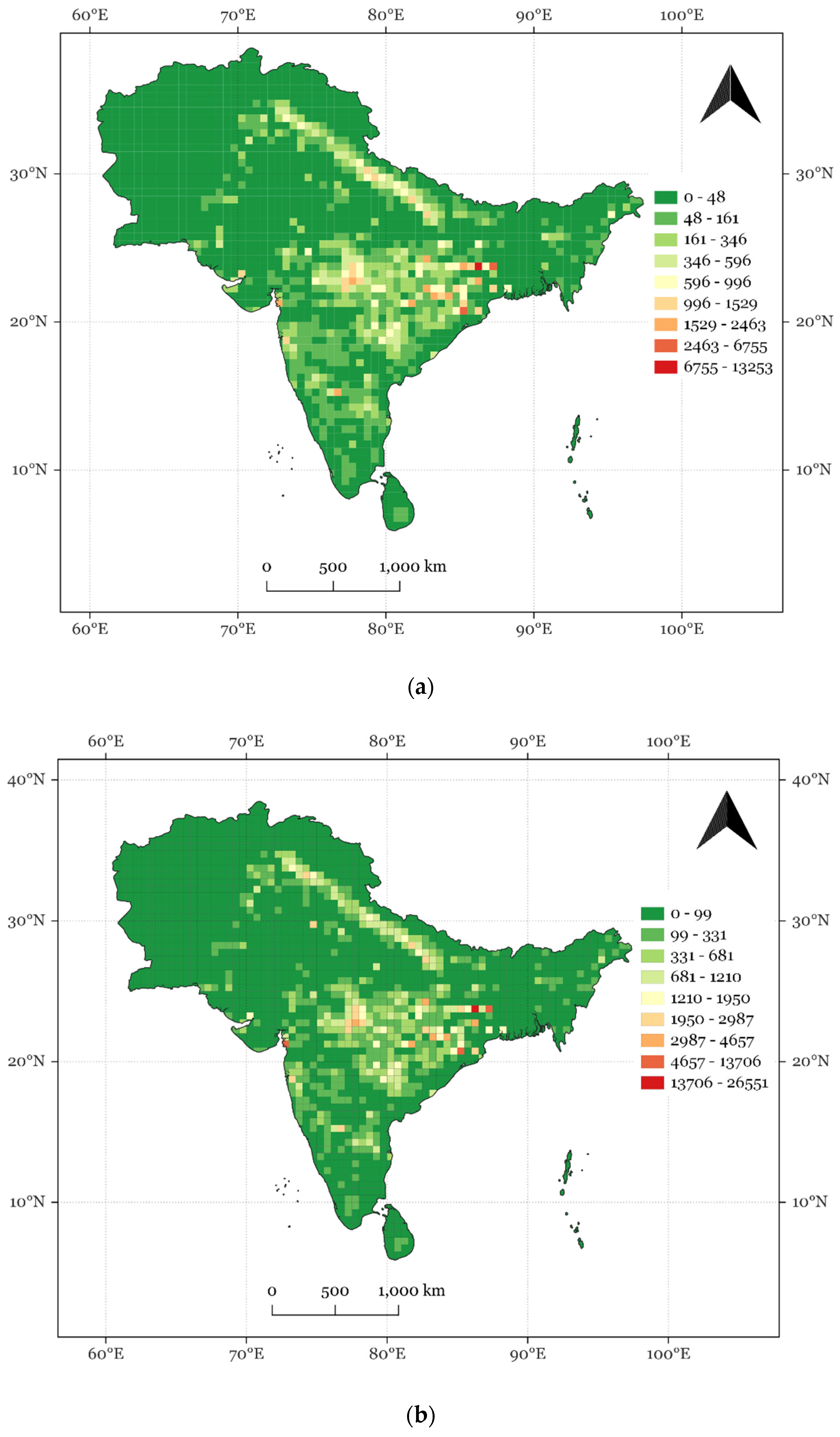

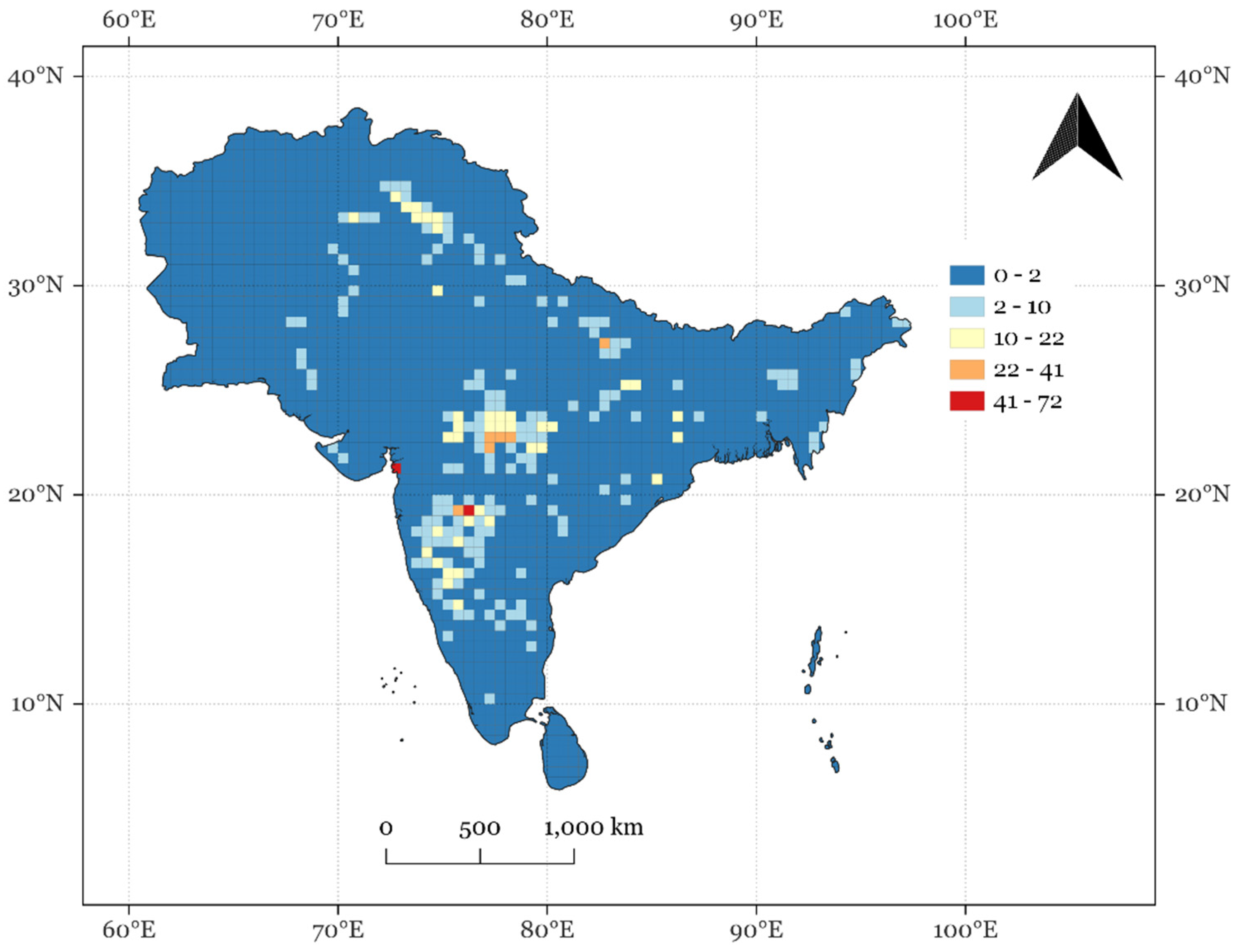

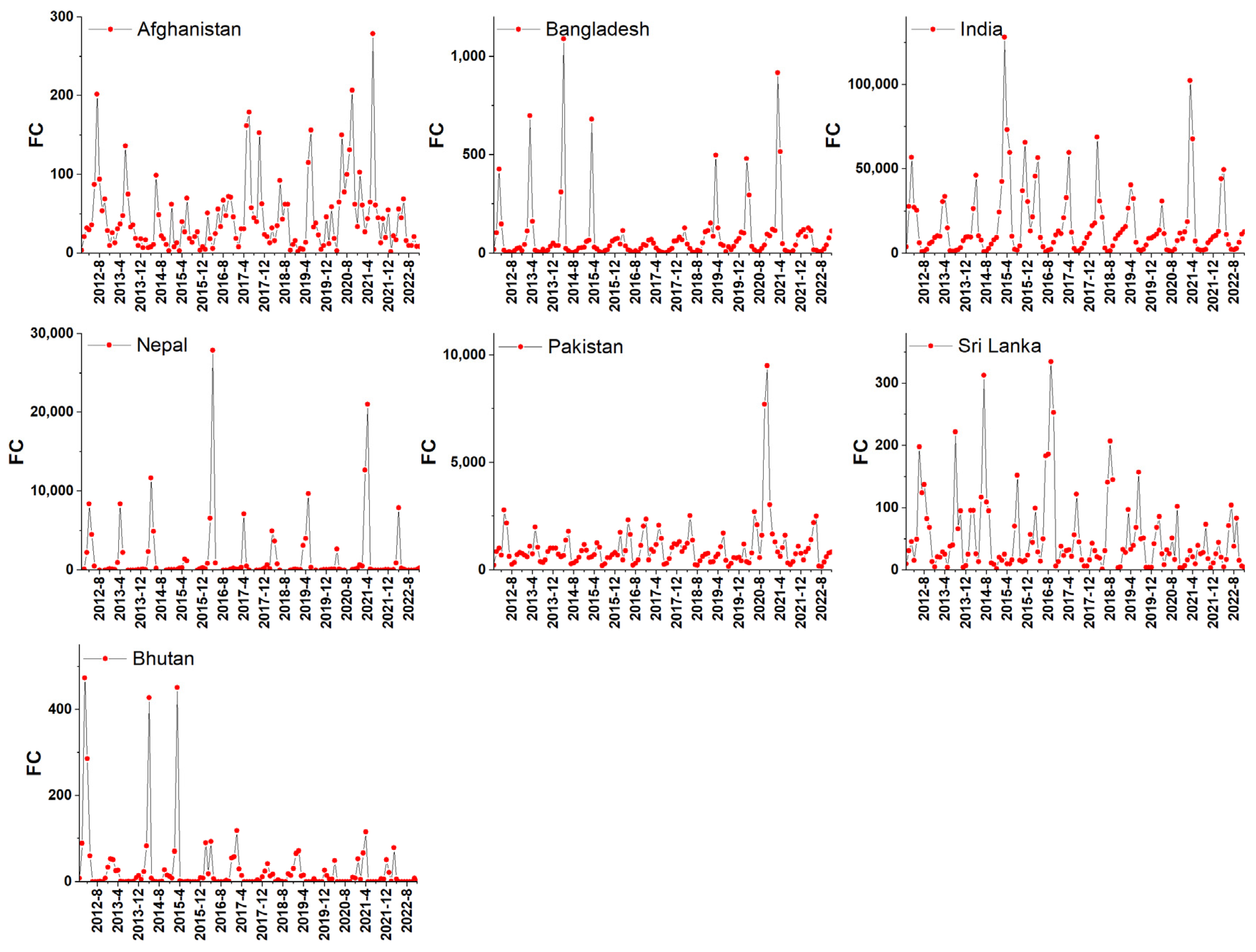
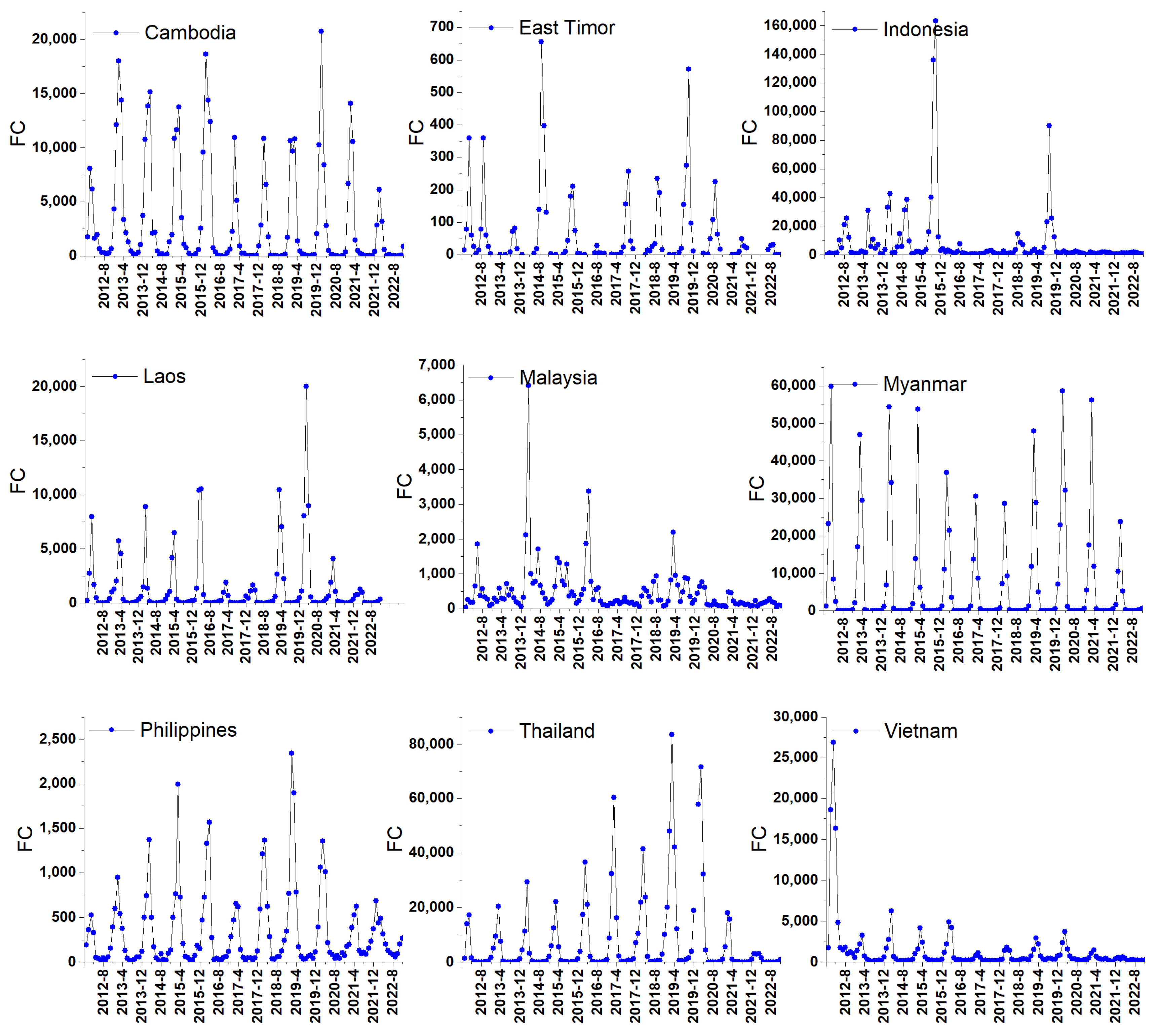
| Country | VIIRS Nighttime Fires | Sentinel SLSTR Nighttime Fires | VIIRS Number of Times Greater Than SLSTR |
|---|---|---|---|
| Afghanistan | 533 | 15 | 36.4 |
| Bangladesh | 1037 | 14 | 73.5 |
| Bhutan | 336 | 9 | 37.3 |
| India | 196,136 | 1505 | 130.4 |
| Nepal | 15,552 | 90 | 172.3 |
| Pakistan | 12,419 | 137 | 90.4 |
| Sri Lanka | 617 | 6 | 101.3 |
| Country | VIIRS Nighttime Fires | Sentinel SLSTR Nighttime Fires | VIIRS Number of Times Greater Than SLSTR |
|---|---|---|---|
| Cambodia | 36,871 | 435 | 85 |
| East Timor | 679 | 10 | 71 |
| Indonesia | 93,649 | 939 | 100 |
| Laos | 14,953 | 274 | 55 |
| Malaysia | 5719 | 61 | 95 |
| Myanmar | 81,522 | 639 | 128 |
| Philippines | 3907 | 51 | 76 |
| Thailand | 88,139 | 471 | 187 |
| Vietnam | 15,542 | 173 | 90 |
| Country | Jan. | Feb. | Mar. | Apr. | May | Jun. | Jul. | Aug. | Sep. | Oct. | Nov. | Dec. |
|---|---|---|---|---|---|---|---|---|---|---|---|---|
| Afghanistan | S | P | E | S | P | E | ||||||
| Bangladesh | S | P | E | |||||||||
| Bhutan | S | P | E | |||||||||
| India | S | P | E | S | P | E | ||||||
| Nepal | S | P | E | |||||||||
| Pakistan | S | P | E | S | P | E | ||||||
| Sri Lanka | S | P | E | S | P | E | ||||||
| Cambodia | S | P | E | |||||||||
| East Timor | S | P | E | |||||||||
| Indonesia | S | P | E | |||||||||
| Laos | S | P | E | |||||||||
| Malaysia | S | P | E | S | P | E | ||||||
| Myanmar | S | P | E | |||||||||
| Philippines | S | P | E | |||||||||
| Thailand | S | P | E | |||||||||
| Vietnam | S | P | E |
| Vegetation Type | Afghanistan | Bangladesh | Bhutan | India | Nepal | Pakistan | Sri Lanka |
|---|---|---|---|---|---|---|---|
| Evergreen Needleleaf Forests | 8 | 0 | 13 | 1322 | 226 | 85 | 0 |
| Evergreen Broadleaf Forests | 0 | 71 | 19 | 2897 | 476 | 2 | 80 |
| Deciduous Needleleaf Forests | 0 | 0 | 0 | 0 | 0 | 0 | 0 |
| Deciduous Broadleaf Forests | 0 | 128 | 3 | 12,820 | 329 | 0 | 0 |
| Mixed Forests | 0 | 16 | 43 | 7705 | 11,161 | 6 | 0 |
| Closed Shrublands | 1 | 0 | 0 | 0 | 0 | 1 | 0 |
| Open Shrublands | 29 | 0 | 0 | 1371 | 0 | 629 | 0 |
| Woody Savannas | 19 | 307 | 99 | 7198 | 2651 | 147 | 219 |
| Savannas | 39 | 270 | 12 | 9719 | 1562 | 685 | 136 |
| Grasslands | 245 | 16 | 13 | 21,544 | 293 | 2555 | 29 |
| Croplands | 37 | 198 | 0 | 62,512 | 393 | 2248 | 25 |
| Cropland/Natural Vegetation Mosaics | 0 | 85 | 0 | 698 | 15 | 24 | 72 |
| Vegetation Type | Cambodia | Indonesia | Laos | Malaysia | Myanmar | Philippines | Thailand | Vietnam |
|---|---|---|---|---|---|---|---|---|
| Evergreen Needleleaf Forests | 0 | 0 | 1 | 0 | 14 | 0 | 0 | 0 |
| Evergreen Broadleaf Forests | 3314 | 43,381 | 12,943 | 1261 | 25,534 | 1588 | 26,715 | 2598 |
| Deciduous Needleleaf Forests | 0 | 0 | 0 | 0 | 0 | 0 | 0 | 0 |
| Deciduous Broadleaf Forests | 976 | 215 | 99 | 0 | 26,258 | 0 | 15,987 | 67 |
| Mixed Forests | 42 | 37 | 28 | 0 | 16,684 | 0 | 1336 | 42 |
| Closed Shrublands | 3 | 14 | 0 | 0 | 3 | 0 | 0 | 0 |
| Open Shrublands | 0 | 0 | 0 | 0 | 0 | 0 | 3 | 0 |
| Woody Savannas | 3941 | 83,204 | 6758 | 2970 | 15,006 | 1554 | 19,863 | 1837 |
| Savannas | 14,540 | 17,987 | 1219 | 881 | 3264 | 1943 | 6917 | 2676 |
| Grasslands | 11,606 | 12,023 | 2159 | 1402 | 3376 | 343 | 2892 | 920 |
| Croplands | 1326 | 1521 | 185 | 29 | 6052 | 321 | 15,861 | 1300 |
| Cropland/Natural Vegetation Mosaics | 48 | 4773 | 2 | 118 | 53 | 326 | 570 | 577 |
| (a) | ||||
| Country | Seasonal Kendall (FC) | p-Value | Kendall Tau (FC) | Sen’s Slope (FC) |
| Afghanistan | 10 | 0.838 | 0.015 | 0 |
| Bangladesh | 239 | 0 | 0.371 | 2 |
| Bhutan | −106 | 0.007 | −0.159 | 0 |
| India | 50 | 0.266 | 0.078 | 47 |
| Nepal | −57 | 0.203 | −0.087 | −0.25 |
| Pakistan | −22 | 0.634 | −0.033 | −2.33 |
| Sri Lanka | −71 | 0.11 | −0.106 | −0.707 |
| (b) | ||||
| Country | Seasonal Kendall (FRP) | p-Value | Kendall Tau (FRP) | Sen’s Slope (FRP) |
| Afghanistan | 16.0 | 0.733 | 0.024 | 0 |
| Bangladesh | 224.0 | 0 | 0.349 | 2.770 |
| Bhutan | −102 | 0.010 | −0.155 | 0 |
| India | 50 | 0.266 | 0.078 | 47.09 |
| Nepal | −55.0 | 0.220 | −0.083 | −0.287 |
| Pakistan | −20.0 | 0.666 | −0.030 | −4.05 |
| Sri Lanka | −40.0 | 0.376 | −0.059 | −0.344 |
| (a) | ||||
| Country | Seasonal Kendall (FC) | p-Value | Kendall Tau (FC) | Sen’s Slope (FC) |
| Cambodia | −120 | 0.007 | −0.188 | −21.00 |
| East Timor | −75 | 0.091 | −0.115 | −0.13 |
| Indonesia | −150 | 0.001 | −0.23 | −100.00 |
| Laos | −65 | 0.145 | −0.098 | −0.50 |
| Malaysia | −186 | 0 | −0.284 | −16.00 |
| Myanmar | 184 | 0 | 0.281 | 3.00 |
| Philippines | 182 | 0 | 0.28 | 6.79 |
| Thailand | 65 | 0.146 | 0.102 | 4.78 |
| Vietnam | −120 | 0.007 | −0.1888 | −21.00 |
| (b) | ||||
| Cambodia | −250.0 | 0 | −0.385 | −81.26 |
| East Timor | -84.0 | 0.060 | −0.129 | −0.210 |
| Indonesia | −158 | 0 | −0.242 | −348.76 |
| Laos | −80 | 0.073 | −0.121 | −1.027 |
| Malaysia | −180 | 0 | −0.275 | −29.96 |
| Myanmar | 114 | 0.010 | 0.173 | 2.143 |
| Philippines | 182 | 0 | 0.280 | 6.792 |
| Thailand | 74.0 | 0.097 | 0.116 | 12.24 |
| Vietnam | −138.0 | 0.002 | -0.215 | −43.675 |
Disclaimer/Publisher’s Note: The statements, opinions and data contained in all publications are solely those of the individual author(s) and contributor(s) and not of MDPI and/or the editor(s). MDPI and/or the editor(s) disclaim responsibility for any injury to people or property resulting from any ideas, methods, instructions or products referred to in the content. |
© 2024 by the authors. Licensee MDPI, Basel, Switzerland. This article is an open access article distributed under the terms and conditions of the Creative Commons Attribution (CC BY) license (https://creativecommons.org/licenses/by/4.0/).
Share and Cite
Vadrevu, K.; Eaturu, A. Trends in Nighttime Fires in South/Southeast Asian Countries. Atmosphere 2024, 15, 85. https://doi.org/10.3390/atmos15010085
Vadrevu K, Eaturu A. Trends in Nighttime Fires in South/Southeast Asian Countries. Atmosphere. 2024; 15(1):85. https://doi.org/10.3390/atmos15010085
Chicago/Turabian StyleVadrevu, Krishna, and Aditya Eaturu. 2024. "Trends in Nighttime Fires in South/Southeast Asian Countries" Atmosphere 15, no. 1: 85. https://doi.org/10.3390/atmos15010085
APA StyleVadrevu, K., & Eaturu, A. (2024). Trends in Nighttime Fires in South/Southeast Asian Countries. Atmosphere, 15(1), 85. https://doi.org/10.3390/atmos15010085





